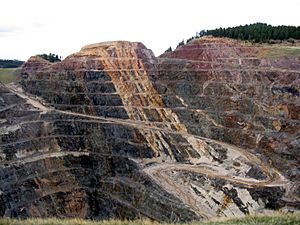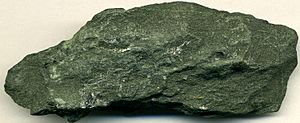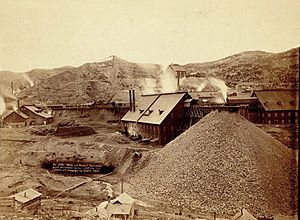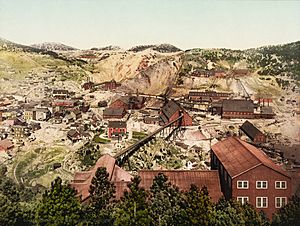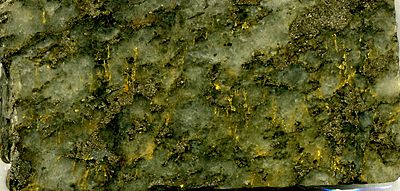Homestake Mine (South Dakota) facts for kids
The Homestake Mine was a very deep gold mine located in Lead, South Dakota. It was the largest and deepest gold mine in North America until it closed in 2002. Over its lifetime, the mine produced more than forty million troy ounces (43,900,000 oz; 1,240,000 kg) of gold. This is a huge amount, enough gold to fill about 18,677 gallons!
The Homestake Mine is also famous in the science world. A special underground laboratory was built there in the mid-1960s. This lab was where the solar neutrino problem was first discovered, thanks to an experiment called the Homestake Experiment. Raymond Davis Jr. led this experiment, which was the first to ever observe tiny particles called solar neutrinos coming from the sun.
On July 10, 2007, the National Science Foundation chose the mine to be the home of the Deep Underground Science and Engineering Laboratory (DUSEL). It was picked over many other places.
A Look at Homestake Mine History
The Homestake gold deposit was found by Fred and Moses Manuel, Alex Engh, and Hank Harney in April 1876. This happened during the Black Hills Gold Rush, when gold was discovered in the Black Hills. This area had been promised to the Lakota Nation by the Fort Laramie Treaty. In 1877, three business owners, George Hearst, Lloyd Tevis, and James Ben Ali Haggin, bought the gold claim for $70,000.
George Hearst arrived in Deadwood in October 1877 and took charge of the mine. He had to arrange for all the heavy mining equipment to be brought in by wagons from Sidney, Nebraska. Even though the mine was in a remote area, deep shafts were dug, and gold ore started to come out. By July 1878, an 80-stamp mill was built to crush the Homestake ore.
In 1879, the partners sold shares in the Homestake Mining Company. It was listed on the New York Stock Exchange. The Homestake company would become one of the longest-listed stocks on the NYSE, as it operated the mine until 2001.
Hearst worked to make the Homestake property bigger. He bought other nearby claims and won others in court. He also bought newspapers in Deadwood to help shape what people thought. Within three years, Hearst had made the mine a success and gained many valuable claims. He left the Black Hills a very rich man.
By March 1879, Hearst had added several more claims to the original two. The mine grew from a ten-stamp mill to 200, and 500 people worked there. Hearst also owned water rights, which gave him control over water for the region. His railroad, the Black Hills & Fort Pierre Railroad, helped him transport goods.
By 1900, Homestake owned 300 claims, covering 2,000 acres (810 ha), and employed more than 2000 workers. In 1901, the mine started using compressed air locomotives, which completely replaced mules and horses by the 1920s. Charles Washington Merrill introduced a new method called cyanidization to get more gold out of the ore. This method helped recover 94 percent of the gold. The gold was then sent to the Denver Mint.
By 1906, some of the mine shafts were very deep. The Ellison Shaft reached 1,550 feet (472 m), and others like the B&M and Golden Star were also over 1,000 feet deep. The mine produced 1,500,000 short tons (1,300,000 long tons; 1,400,000 metric tons) of ore. There were two big fires in the mine, one in 1907 and another in 1919.
In 1927, a company geologist named Donald H. McLaughlin showed that gold ore reached a depth of 3,500 feet. New shafts and deeper tunnels were started in the 1930s. Gold production stopped during World War II, from 1943 to 1945, because of a government order. By 1975, mining operations had reached the 6,800-foot (2,073 m) level.
The gold ore found at Homestake was considered low grade, meaning it had less than one ounce of gold per ton of rock. However, there was a huge amount of this ore. By 2001, the mine had produced 39,800,000 troy ounces (43,700,000 oz; 1,240,000 kg) of gold and 9,000,000 troy ounces (9,870,000 oz; 280,000 kg) of silver. The Lead mining district, where Homestake was the only producer, was the second-largest gold producer in the United States. Homestake was also the longest continuously operating mine in U.S. history.
The Homestake mine stopped producing gold at the end of 2001. This happened because gold prices were low, the quality of the ore was not as good, and the costs to run the mine were very high.
From Mine to Science Lab
After the mine closed, the Barrick Gold company (which had joined with Homestake Mining Company) agreed in early 2002 to keep pumping water out of the mine. This was done while they talked with the National Science Foundation about using the mine as a new deep underground laboratory (DUSEL). But progress was slow, and keeping the pumps and ventilation running cost $250,000 each month. So, the owners turned off the equipment on June 10, 2003, and closed the mine completely.
However, the Homestake Mine was indeed chosen in 2007 by the NSF for the Deep Underground Science and Engineering Laboratory (DUSEL). In June 2009, scientists at University of California Berkeley announced that Homestake would be reopened for scientific research. They would study neutrinos and dark matter particles using DUSEL and the Large Underground Xenon experiment.
Scientists are also preparing to research enhanced geothermal systems in the mine. This involves using the Earth's heat for energy.
Understanding Homestake Geology
The gold at Homestake is mostly found in a rock layer called the Homestake Formation. This layer formed very early in Earth's history and contains iron carbonate and iron silicate. The Homestake Formation was originally 20–30 meters thick. Over time, it was squeezed and changed by heat and pressure, a process called metamorphosis. This created different types of rocks like siderite-phyllite and grunerite schists.
The iron in these rocks might have been deposited by ancient volcanoes, possibly with the help of tiny microorganisms. This process created what is known as a banded iron formation. The most gold ore was found in areas called the Main Ledge, near the surface, and the 9 Ledge, which was about 3200 feet deep.


